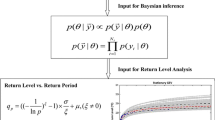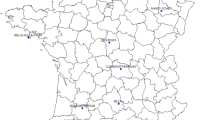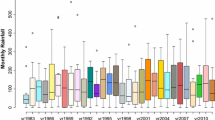Abstract
In this paper we introduce a model evaluation and comparison metric based on the methodology introduced in Faranda et al. (Geophys Res Lett 40(21):5782–5786, 2013) to assess biases and their potential origins in a historical model simulation against long-term reanalysis. The metric is constructed by exploiting recent results of dynamical systems theory linking rare recurrences to the classical statistical theories of extreme events for time series. We compute rare recurrences for 100 years daily mean temperatures data obtained in a model with historical greenhouse forcing (the Institut Pierre-Simon Laplace, IPSL-CM5 model) and compare them with the same quantities obtained from two datasets of reanalysis (twentieth Century Reanalysis and ERA 20C). The period chosen for the comparison is 1900–2000 and the focus is on the European region. We show that with respect to the traditional approaches, the recurrence technique is sensitive to the change in the size of the selection window of extremes due to the conditions imposed by the dynamics.










Similar content being viewed by others
References
Anderson TW, Darling DA (1954) A test of goodness of fit. J Am Stat Assoc 49(268):765–769
Beniston M (2006) Mountain weather and climate: a general overview and a focus on climatic change in the Alps. Hidrobiologia 1(562):3–16
Brown S, Caesar J, Ferro CA (2008) Global changes in extreme daily temperature since 1950. J Geophys Res Atmos 113(D5) (1984–2012)
Cattiaux J, Quesada B, Arakelian A, Codron F, Vautard R, Yiou P (2013) North-Atlantic dynamics and european temperature extremes in the IPSL model: sensitivity to atmospheric resolution. Clim Dyn 40(9–10):2293–2310
Coles S (2001) An Introduction to statistical modeling of extreme values. Springer, New York
Compo GP, Whitaker JS, Sardeshmukh PD, Matsui N, Allan RJ, Yin X, Gleason BE, Vose R, Rutledge G, Bessemoulin P et al (2011) The twentieth century reanalysis project. Q J R Meteorol Soc 137(654):1–28
Dufresne JL, Foujols MA, Denvil S, Caubel A, Marti O, Aumont O, Balkanski Y, Bekki S, Bellenger H, Benshila R et al (2013) Climate change projections using the IPSL-CM5 earth system model: from CMIP3 to CMIP5. Clim Dyn 40(9–10):2123–2165
Faranda D, Vaienti S (2013) A recurrence-based technique for detecting genuine extremes in instrumental temperature records. Geophys Res Lett 40(21):5782–5786
Faranda D, Lucarini V, Turchetti G, Vaienti S (2011) Numerical convergence of the block-maxima approach to the generalized extreme value distribution. J Stat Phys 145(5):1156–1180
Faranda D, Lucarini V, Turchetti G, Vaienti S (2012) Generalized extreme value distribution parameters as dynamical indicators of stability. Int J Bifurcat Chaos 22(11):1250,276
Faranda D, Freitas JM, Lucarini V, Turchetti G, Vaienti S (2013) Extreme value statistics for dynamical systems with noise. Nonlinearity 26(9):2597
Faranda D, Bourgoin M, Miralles S, Odier P, Pinton JF, Plihon N, Daviaud F, Dubrulle B (2014) Robust estimate of dynamo thresholds in the von Kármán sodium experiment using the extreme value theory. New J Phys 16(8):083,001
Freitas ACM, Freitas JM, Todd M (2010) Hitting time statistics and extreme value theory. Probab Theory Relat Fields 147(3–4):675–710
Frisch HL (1956) Poincaré recurrences. Phys Rev 104(1):1
Galambos J (1980) The asymptotic theory of extreme order statistics. Wiley, New York
Ghil M, Yiou P, Hallegatte S, Malamud B, Naveau P, Soloviev A, Friederichs P, Keilis-Borok V, Kondrashov D, Kossobokov V et al (2011) Extreme events: dynamics, statistics and prediction. Nonlinear Process Geophys 18(3):295–350
Gnedenko B (1943) Sur la distribution limite du terme maximum d’une série aléatoire. Ann Math pp 423–453
Gumbel EJ (1958) Statistics of extremes. Columbia University Press, New York
Hernández-Ceballos J, MAand Adame, Bolívar J, De la Morena B (2013) A mesoscale simulation of coastal circulation in the Guadalquivir valley (southwestern Iberian peninsula) using the WRF-ARW model. Atmos Res 124:1–20
Hourdin F, Foujols MA, Codron F, Guemas V, Dufresne JL, Bony S, Denvil S, Guez L, Lott F, Ghattas J, Braconnot P, Marti O, Meurdesoif Y, Bopp L (2013a) Impact of the LMDZ atmospheric grid configuration on the climate and sensitivity of the IPSL-CM5A coupled model. Clim Dyn 40(9–10):2167–2192
Hourdin F, Grandpeix JY, Rio C, Bony S, Jam A, Cheruy F, Rochetin N, Fairhead L, Idelkadi A, Musat I, Dufresne JL, Lahellec A, Lefebvre MP, Roehrig R (2013b) LMDZ5b: the atmospheric component of the IPSL climate model with revisited parameterizations for clouds and convection. Clim Dyn 40(9–10):2193–2222
Katz R (2010) Statistics of extremes in climate change. Clim Change 100(1):71–76
Katz R, Brown B (1992) Extreme events in a changing climate: variability is more important than averages. Clim Change 21(3):289–302
Leadbetter MR, Lindgren G, Rootzén H (1983) Extremes and related properties of random sequences and processes, vol 2. Springer, New York
Lilliefors HW (1969) On the Kolmogorov-Smirnov test for the exponential distribution with mean unknown. J Am Stat Assoc 64(325):387–389
Lorenz EN (1963) Deterministic nonperiodic flow. J Atmos Sci 20(2):130–141
Lucarini V, Faranda D, Turchetti G, Vaienti S (2012) Extreme value theory for singular measures. Chaos Interdiscip J Nonlinear Sci 22(2):023,135
Lucarini V, Faranda D, Wouters J, Kuna T (2014) Towards a general theory of extremes for observables of chaotic dynamical systems. J Stat Phys 154(3):723–750
Nikulin G, Kjelsström E, Hansson U, Strandberg G, Ullerstig A (2011) Evaluation and future projections of temperature, precipitation and wind extremes over Europe in an ensemble of regional climate simulations. Tellus A 63(1):41–55
Pickands III J (1975) Statistical inference using extreme order statistics. Ann Stat pp 119–131
Poli P, Hersbach H, Tan D, Dee D, Thepaut JN, Simmons A, Peubey C, Laloyaux P, Komori T, Berrisford P, et al (2013) The data assimilation system and initial performance evaluation of the ECMWF pilot reanalysis of the 20th-century assimilating surface observations only (ERA-20C)
Rivas-Martínez S, Asensi A, Díez-Garretas B, Molero J, Valle F (1997) Biogeographical synthesis of Andalusia (southern Spain). J Biogeogr 24(6):915–928
Sippel S, Mitchell D, Black MT, Dittus AJ, Harrington L, Schaller N, Otto FE (2015) Combining large model ensembles with extreme value statistics to improve attribution statements of rare events. Weather Clim Extreme 9:25–35
Terzago S, Cassardo C, Cremonini R, Fratianni S (2010) Snow precipitation and snow cover climatic variability for the period 1971–2009 in the southwestern Italian Alps: The 2008–2009 snow season case study. Water 2(4):773–787
Yiou P, Nogaj M (2004) Extreme climatic events and weather regimes over the north atlantic: When and where? Geophys Res Lett 31(7):
Yiou P, Dacunha-Castelle D, Parey S, Huong Hoang T (2009) Statistical representation of temperature mean and variability in Europe. Geophys Res Lett 36(4)
Acknowledgments
D. Faranda and P. Yiou were supported by ERC Grant No. 338965-A2C2 and M. Carmen Alvarez-Castro was supported by the Swedish Research Council Grant: “Euro-Atlantic climate variability during the last millennium: atmospheric circulation and extreme events (MILEX)”.
Author information
Authors and Affiliations
Corresponding author
Rights and permissions
About this article
Cite this article
Faranda, D., Alvarez-Castro, M.C. & Yiou, P. Return times of hot and cold days via recurrences and extreme value theory. Clim Dyn 47, 3803–3815 (2016). https://doi.org/10.1007/s00382-016-3042-6
Received:
Accepted:
Published:
Issue Date:
DOI: https://doi.org/10.1007/s00382-016-3042-6




